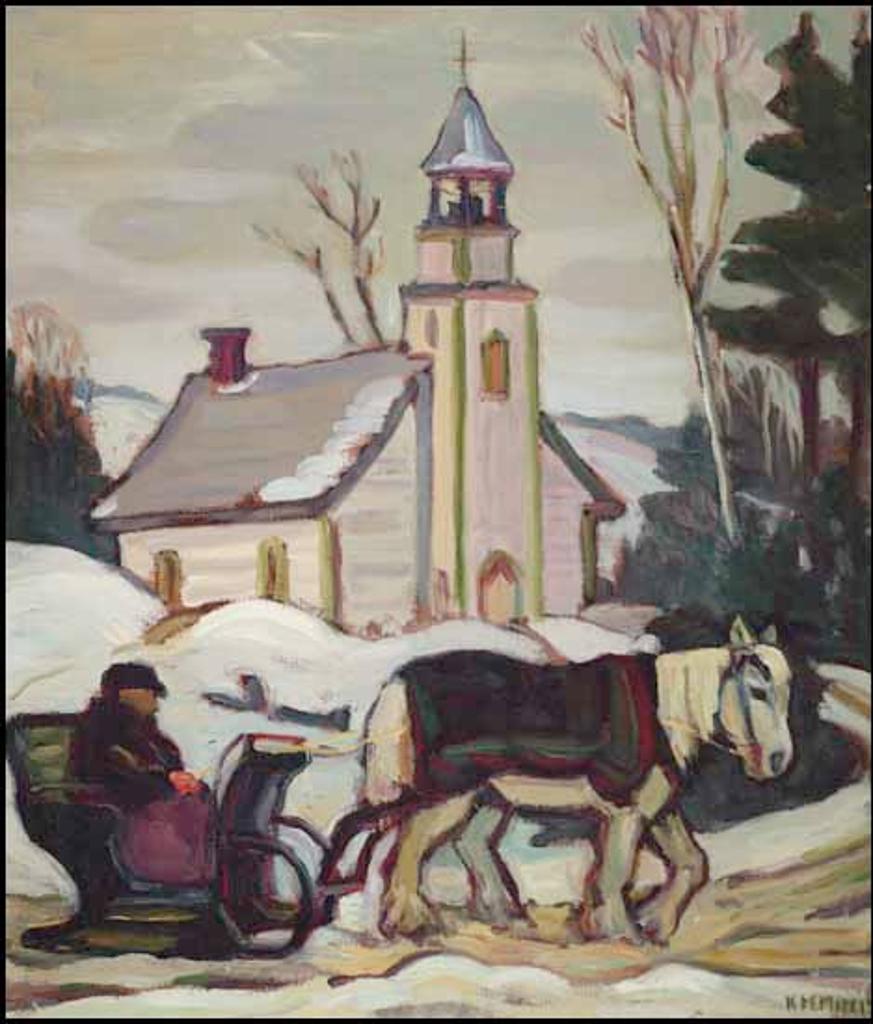
Study in White, Winter, Berthier
61 cms x 51.4 cms (24 ins x 20.25 ins)
Signed
Lot offered for sale by Heffel, Vancouver at the auction event "Fine Canadian Art Spring 2006 Live auction" held on Thu, May 25, 2006.
Lot 051
Lot 051
Estimate: CAD $80,000 - $100,000
Realised: CAD $299,000
Realised: CAD $299,000
Lot description - from the online catalogue*
Provenance:
Kaspar Gallery, Toronto
Private Collection, Ontario
Literature:
Kathleen Moir Morris. Agnes Etherington Art Centre, Queen's University, Kingston, Ontario, 1983, page 13
Notes:
The area of Berthierville (once Berthier-en-haut), north of the Saint Lawrence, was an often represented and much loved painting place for Kathleen Morris during the early 1920s. As Michael Dunn has recounted, she felt "It had everything. snow, horses, a town centre with church and buildings. Her mother would take her to Berthier[ville] for a month to six weeks each winter, for several winters." Certainly Kathleen Morris's paintings of Berthier eloquently describe her interest in conveying the living dimension of a given environs - the place, the people and the nostalgia of a way of life. But such scenes also afforded the opportunity for pure formal investigation. Study in White, by its very title, reveals the artist's primary concern with the pictorial and architectonic aspects of her work. Like her colleagues of the Group of Seven and the Beaver Hall Group, Morris was among the generation of artists whose intelligent investigation into a modernist syntax led them beyond subjects of sentiment and narrative to concerns with form, colour and personal expression. Her rigorous training at the Art Association of Montreal under William Brymner, and the outdoor sketching excursions she took with Maurice Cullen to places such as Carillon, Quebec, undoubtedly fostered the artist's facility at painting en plein air. Winter scenes such as Study in White, with its boldly centralized composition, dynamic arrangement of verticals and horizontals and surprising tonal play, serve to demonstrate Morris's uniqueness and remarkable ability as a female art practitioner in the early decades of the twentieth century.
Kaspar Gallery, Toronto
Private Collection, Ontario
Literature:
Kathleen Moir Morris. Agnes Etherington Art Centre, Queen's University, Kingston, Ontario, 1983, page 13
Notes:
The area of Berthierville (once Berthier-en-haut), north of the Saint Lawrence, was an often represented and much loved painting place for Kathleen Morris during the early 1920s. As Michael Dunn has recounted, she felt "It had everything. snow, horses, a town centre with church and buildings. Her mother would take her to Berthier[ville] for a month to six weeks each winter, for several winters." Certainly Kathleen Morris's paintings of Berthier eloquently describe her interest in conveying the living dimension of a given environs - the place, the people and the nostalgia of a way of life. But such scenes also afforded the opportunity for pure formal investigation. Study in White, by its very title, reveals the artist's primary concern with the pictorial and architectonic aspects of her work. Like her colleagues of the Group of Seven and the Beaver Hall Group, Morris was among the generation of artists whose intelligent investigation into a modernist syntax led them beyond subjects of sentiment and narrative to concerns with form, colour and personal expression. Her rigorous training at the Art Association of Montreal under William Brymner, and the outdoor sketching excursions she took with Maurice Cullen to places such as Carillon, Quebec, undoubtedly fostered the artist's facility at painting en plein air. Winter scenes such as Study in White, with its boldly centralized composition, dynamic arrangement of verticals and horizontals and surprising tonal play, serve to demonstrate Morris's uniqueness and remarkable ability as a female art practitioner in the early decades of the twentieth century.
Most realised prices include the Buyer's Premium of 18-25%, but not the HST/GST Tax.
(*) Text and/or Image might be subject matter of Copyright. Check with Heffel auction house for permission to use.
(*) Text and/or Image might be subject matter of Copyright. Check with Heffel auction house for permission to use.